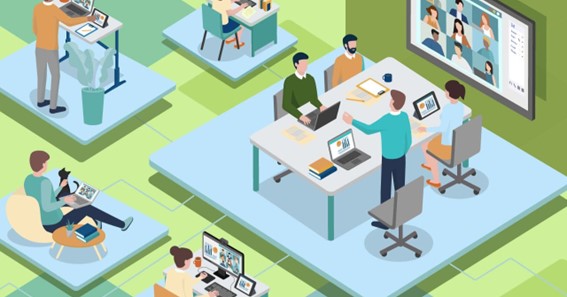As organizations implement hybrid workplace arrangements, employees require improved tools to help them manage this shift. The lines between our personal and professional lives have become increasingly hazy in this current lifestyle. The transition to hybrid work will require enhanced management of time and space. As we return to the office, our top task is to determine how we spend our time in the office optimally.
Best tips to design an optimal hybrid workplace
- To be successful, strategic planning is essential:
Individuals must actively manage and coordinate timelines and boundaries at work and home. Coordinating and synchronizing office days with essential team members is important. This is one way to take advantage of areas and resources not available at home while at work. This includes huddle spaces and other rooms with whiteboards and video conferencing capabilities.
Creating a calendar of activities for the entire team can be a helpful way to organize everyone’s schedule. It is necessary to analyze and identify which kinds of surroundings are appropriate for the different types of work you perform.
- Flexible work schedules led by managers:
Your manager will determine your flexible hybrid workplace schedule as a general rule. This demonstrates that they are adaptive, but only to the extent that their manager is malleable. In this case, you and your manager will determine the parameters of your hybrid schedule through direct collaboration.
In a flexible work model, your manager will determine which days you must be in the office. Companies with a bit more latitude regarding customer facing positions best implement flexible scheduling.
For example, suppose you discover in-person collaboration is still valuable to your group’s efforts. In that case, it’s great to schedule specific days when you know you’ll be able to collaborate with your team physically. You can also continue working from home whenever it is not required, which means you can do so on most days.
- Implement solutions for employees to communicate and collaborate:
It is essential to consider how your employees find one another in the office. They should also know which days their colleagues come to the office. As our work schedule gets less predictable, it is important that we use solutions that support easy communication and collaboration.
Collaboration technology with features like calendar integration, occupancy counting, wayfinding, and geo-location integration will make it simpler to:
– search, select, and book desks and meeting rooms.
– monitor the level of occupancy.
– make it easier to locate and collaborate with colleagues in a more dynamic environment.
- Employee experience influences productivity:
As many firms use hybrid organizational structures, it is essential to select technologies that enhance the employee experience and boost productivity. The simplicity of adoption and operation must be of the utmost importance when picking devices and applications. Increasing productivity through the usage of technology simplifies collaboration. Remote workers should have the same access as in-office workers to technological tools that enhance productivity and collaboration.
Employees working from home should have access to improved technology as per their needs. This can be things like multiple displays, headphones that cancel noise, and superior microphones.
- Safety concerns:
The hybrid workplace paradigm confronts organizations with a new set of issues. It is difficult to determine how much access remote workers can have to the company’s confidential data.
The epidemic has driven employees to utilize their gadgets for work. This increases compliance, security, and privacy issues.
Additionally, calls made from personal devices are not logged and cannot be integrated into customer relationship management software. Employees who disclose personal information, such as their cell phone numbers, waive their right to privacy.
- Upskill employees:
The leaders of a digital workplace must integrate learning and innovation into the company’s core structure. They must increase their investment in upskilling their employees. They should ensure that they receive training on the most recent software and applications. You should give priority to training employees individually or in small groups.
A superior hybrid workplace results in improved employee experiences. These will generate strategic organizational goals such as higher employee engagement, increased customer satisfaction, high levels of efficiency, and increased collaboration.
- Provide accessible information:
While working in a diverse atmosphere, it is possible to grow isolated. Some office workers may have better chances of acquiring knowledge quickly, which may also come to them instinctively. This will probably lead to conflict between various factions.
However, there is no reason for alarm because this is not necessarily the case if knowledge is available to everyone. If people desire information, they should not feel helpless when attempting to acquire it.
You can establish open communication channels and utilize technology tools effectively. The days when a memo posted on the bulletin board was adequate are long gone. Instead of conventional techniques, disseminate company updates using email, social media, and messaging apps.
If you have established an online employee portal, then you can also create a frequently asked questions (FAQ) page. On that page, you can answer queries related to corporate policies, different technologies used in the company, and so on. Encourage regular huddles in which employees can discuss updates and best practices to keep small teams in constant contact.
Conclusion
By keeping the above tips in mind, you will be able to build an organized hybrid workplace. Providing workers with various flexible collaboration choices necessitates the development of multiple meeting room solutions that can seamlessly integrate remote participants. The deployment of touchless technology and support for overflow areas will contribute to the consumer’s health and safety. The ubiquitous availability of communications, calendaring, and location services will generate channels for sending out messages and establishing connections.
Lastly, hybrid workplace analytics may help you get a holistic perspective before making office space related decisions. You will get essential data to support decisions on the present and future of workplace space and technology.






